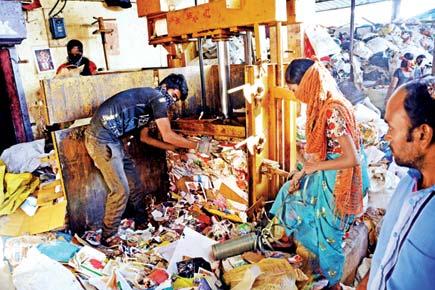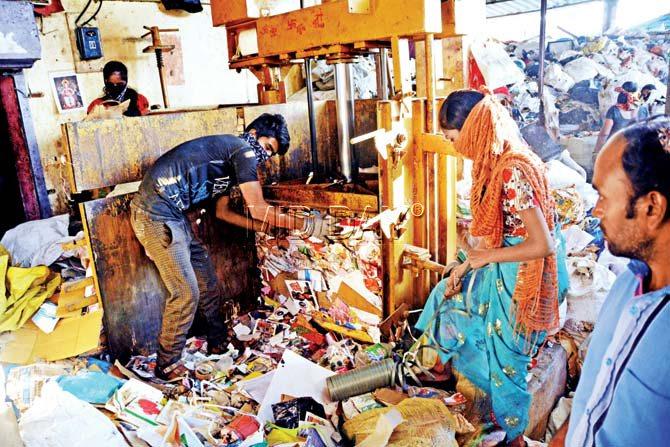Of the 10,500 metric tonnes of garbage generated in Mumbai every day, only 1,200 metric tonnes is segregated at source. The unsegregated trash ends up choking the city

At a waste segregation centre in Bhimwadi, Chembur, run by the BMC and NGO Stree Mukti Sanghatana, Rajesh Rajbhar, the acting in-charge for the day, educates us on scrap terminologies. Pointing to a sack full of used plastic water bottles, he says, “That’s called teri in the scrap market at Mandala in Chembur East.” Then, he draws our attention to soft plastics, the kind used in food packaging. “That’s fuga. It fetches a good price.” Milk bags are called panni, oilcans are jhaap, brown cardboard is putta, and shoe soles are called, well, soles.

Sorters use a beller machine to compress paper and plastic waste into bricks, which will be sent to recycling units. Pic/Sayyed Sameer Abedi
ADVERTISEMENT
The segregation centre is a small structure, sitting on barren land, called Helipad Ground, offset by shanties in the backdrop. The ground got its rather unusual moniker after a helicopter flying a former Indian President landed there, says a local.
Of the 10,500 metric tonnes of garbage generated in Mumbai every day, only 1,200 metric tonnes is segregated at source. The rest is sent to three dumping grounds unsegregated, to the delight of local ragpickers. SUNDAY mid-day’s visit to four of the 34 segregation centres — Chembur, Govandi, Worli and Dharavi — traces the journey of a trash from home to dumpyard.
Burning dump
A fire broke out at the 120-hectare Deonar dumping ground on January 27, leading to a blanket of smoke over parts of the eastern suburbs, the island city and Navi Mumbai. Firefighting was underway even on Saturday. The fire had a crucial lesson for Mumbaikars — segregate or perish — since it was dry trash that had caught fire that fateful day.
Around 3,000 MT of waste is sent to Deonar, 3,000 MT to Kanjurmarg and the rest to Mulund. The High Court has repeatedly directed the BMC to close Mulund and Deonar dumping grounds since they had exceeded their capacity. The BMC had declared that it would undertake scientific disposal of waste at both, and eventually shut them down. The contracts are yet to be re-invited. Besides, a biomethanization project, a waste to energy project was also announced, but neither have seen the light of the day.
Several of the 34 dry waste centres are run by NGOs such as Stree Mukti Sanghatana on no-profit, no-loss basis. They employ local men and women who segregate and send solid waste for recycling and are paid daily wages or a monthly salary.
“The problem is that people don’t segregate at source. No matter what measures we take, it is a mammoth job to manage unsegregated waste,” said outgoing solid waste management chief Prakash Patil.
However, Dr Sandip Rane, an activist who has been pursuing the Deonar dumping ground matter with the BMC for decades, said, “BMC needs a lesson or two. There is rampant corruption in every department of the civic body. They are not serious about solving the problem of solid waste.”
Ragpicker diary
About six workers of the Sanghatana were at Deonar when SUNDAY mid-day paid a visit. A total of 12 members of the NGO segregate three trucks full of dry waste here every day.
Akeel Khan, one of the segregators, is from UP’s Sultanpur village. He said, “I have been working here for five years. It is steady money. None of us think of smuggling out of the waste because we will lose our jobs. All the solid waste of the area is brought here. Wet waste goes to Deonar.”
Khan works from 7 am to 6 pm and is paid R10,000 per month. He lives, eats and sleeps on the site like many others. He goes about without gloves, masks or any protective gear. Several workers suffer cuts and burns while on the job. They have to bear the medical costs themselves. “It is a lot of hard work. But we are not educated, what else can we do?” said Munni Khan, another ragpicker.
Over at Worli, the BMC’s office has a glass-façade building. One can barely imagine that about 1,500 kgs of waste is brought in the space behind it every day. The dry waste segregation here is done by an NGO called Force while wet is segregated by an NGO called Kalpana.
Riyaz Ahmed works for the former. He says he can sift through five sacks of dry waste in 15-20 minutes. The thick plastic objects are the most profitable ones. They can be sold for Rs 25 per kg but are rare. While the paper and cardboard from here goes to Andheri, plastic goes to Do Taaki, a scrap centre near Chor Bazaar.
E-waste catch
At the Bhimwadi segregation unit, e-waste is a special delivery. On Friday, computer parts from Guru Nanak College, SIES College (both in Sion) and Indian Association for Promotion of Adoption of Child Welfare have arrived. Rashmi Joshi, the e-waste coordinator from Sanghatana, thinks it has been a good catch. “These parts will be taken to Eco Friend Industries, where a systematic dismantling of parts is done. Plastics, wires and metals are removed separately. Hazardous chemicals are naturalised and effluents are released into the sea,” she says.
A day’s e-waste collection amounts to one tonne here. Stumbling on waste strewn about, Joshi says they try to make maximum use of every piece of dry waste. From PET bottles, for instance, the caps, the bottle and the wrapper around it are separated, and each is sent to different recycling units. “But, we have to wait till we reach at least 500 kg of each material. Which is why these piles are lying around here,” she explains.
Waste economics
The Sanghatana runs seven segregation sites across Mumbai, including Churchgate. The one at Bhimwadi caters to M-West Ward (Chembur West), and has tied up with recycling firms and consultants to achieve an ecosystem of sorts. “The BMC is overburdened. We want to give them a helping hand,” says Joshi. Looking at the 10 people working at the segregation centre, sifting through dry waste generated by more than 4 lakh people in Chembur West, the imbalance is self-evident. You do the math.
 Subscribe today by clicking the link and stay updated with the latest news!" Click here!
Subscribe today by clicking the link and stay updated with the latest news!" Click here!







